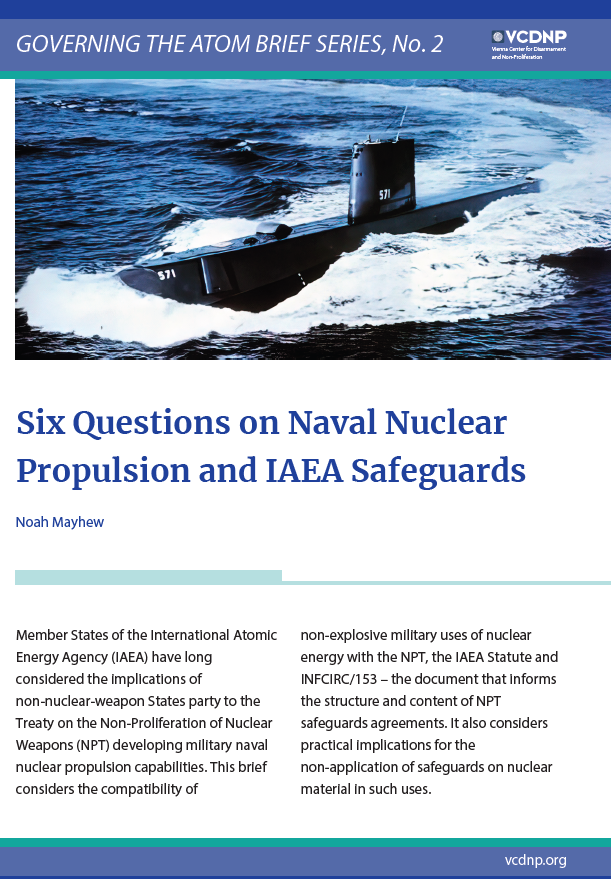
Dr. Nikolai Sokov
Senior Fellow
Vienna Center for Disarmament and Non-Proliferation

As recent reports indicate, the United States is preparing to withdraw from the Open Skies Treaty (OST). The concern is not new—preparations for the withdrawal were first reported in October 2019. Given that background, the probability of such a step appears very high.
The Open Skies Treaty, which was first proposed by President Eisenhower in 1955, signed in 1992, and entered into force in 2002, is a major confidence building measure, which ensures a high degree of transparency regarding military activities in Europe and North America. Surveillance flights, which are conducted by specially equipped and certified aircraft according to agreed quotas, serve as reasonably reliable insurance against a clandestine concentration of troops (making a surprise attack unlikely), provide important insights into military exercises and other significant military activities, enhance transparency with regard to deployments of a broad variety of military assets, and—though not originally a purpose, but an almost unexpected boon—help international monitoring of areas of conflict, such as the one continuing in Eastern Ukraine. Obviously, losing such an important tool would be very harmful to international security.
The implementation of the Treaty has not been without problems; in fact, in recent years these have multiplied and become more controversial. Yet, an in-depth, balanced analysis by the Deep Cuts Project demonstrates, these are not critical and can be resolved. Moreover, according to Elena Chernenko’s well-researched article, Russia has recently shown a new level of flexibility with regard to these controversies. Given the Trump administration’s record of maintaining a highly negative attitude toward any international regimes, including those related to security, no amount of flexibility may be enough to prevent a US withdrawal.
An obvious question, then, is whether the OST can survive US withdrawal. Although participation of the United States is critically important for the continuing relevance of that regime, its withdrawal does not automatically mean its demise—unlike the bilateral 1987 Intermediate Nuclear Forces (INF) Treaty, the multilateral OST can continue, at least legally, even without US participation.
Washington must provide a notification about its intent to withdraw no later than the middle of August if it wants to complete the process before 20 January 2021 (withdrawal becomes official six months after notification). But the fate of the OST may be decided sooner, because the remaining members of the OST will need to assemble for a conference, between 30 and 60 days from the date of US notification, in order to discuss the implications of a party’s withdrawal and to reallocate quotas of that country. Effectively, at that conference, the remaining 33 parties will decide on whether the OST will continue.
Even worse, if the notification about intent to withdraw is provided soon, the conference will have to take place in May or June—a challenging time given the COVID-19 pandemic. A videoconference is possible, but given the high sensitivity of the issue, that format is less likely to produce a decision to continue the Treaty—or any decision at all, for that matter.
There are reasons to believe that the OST can continue without US participation. This would help preserve it for the critically important region—Europe, which was, in fact, the main focus of the OST from the beginning. There also is an important precedent, the Joint Comprehensive Plan of Action (JCPOA) on the Iranian nuclear program, which continues to function in spite of US withdrawal.
Such hopes are not unfounded. In November 2019, when reports about an impending US withdrawal appeared for the first time, Deputy Foreign Minister Sergey Ryabkov indicated that Russia would not automatically leave the OST in case of US withdrawal. “We have different options for response,” he said, “but we cannot simply mirror [the US’s action].”
Furthermore, even if the Trump administration decided to withdraw from the OST, but lost this year’s election, the next US administration could, in theory, return to the Treaty, as well as to the JCPOA. This would revive two important regimes helping to strengthen international security and improve the overall political climate.
That said, there are strong reasons for Russia to withdraw from the OST following the United States. Although, as excellent research by Alexander Graef and Moritz Kütt indicates, the bulk of Russian flights have been over Europe (thus US withdrawal will not radically affect the volume of data collected by Moscow), an even greater share of flights by NATO countries have been over Russia. That pattern will continue (reallocation of US quotas will only marginally reduce the number of flights over Russia). It would be only logical for Moscow to suspect that European members of NATO will still collect the same volume of data and will share it with Washington even though Russia will lose its ability to fly over the United States.
Obviously, Russia benefits from the continuation of the OST because it is able to collect valuable data about NATO forces and activities in Europe. On the other hand, it could benefit from denying similar data about itself to NATO. Which is more beneficial to Russia is hard to say—this will be a political decision and subject to the political winds in the Kremlin several months from now, which are difficult to predict.
NATO countries may try to alleviate Russian concerns by reaffirming their obligation under the OST not to share data with non-parties. It is difficult, however, to know what kind of assurances will be viewed as sufficiently credible by Moscow: it might demand more than European NATO states will be prepared to give. Worse, even a simple reaffirmation may not be easy to agree upon within NATO: the Treaty already contains the confidentiality clause and some state parties may argue that no additional assurances are needed.
The situation will be further complicated by an unavoidable conflict between obligations under the North Atlantic Treaty and the non-disclosure obligation under the OST. If, during an OST flight, a member of NATO discovered information that pertains to the security of the Alliance, will the OST provisions prevent it from sharing that information with the United States, who is the main provider of security for European members of NATO? Will it be at all possible to limit the sharing of data within joint NATO structures? Moscow is certain to assume that the United States will have full access to all data its allies collect over Russia. Whether it will be prepared to overlook it, is a different matter.
Moscow’s decision on whether it stays in the OST will be influenced by the collapse of the INF Treaty. The United States withdrew from the INF Treaty citing Russian violations; now Washington cites Russian violations of the OST as a reason for the next withdrawal. From the Russian perspective, it tried to resolve American concerns about the implementation of the INF Treaty, but its initiatives were rejected, and now it sees a repetition of the same pattern.
As mentioned above, Moscow has demonstrated flexibility regarding American accusations of non-compliance to the OST. As was the case with the INF Treaty, many of the proposals are tabled as packages—concessions by Russia in exchange for concessions by the West. For example, Russia has reportedly agreed to allow flights within the 10-kilometer zone from the border of Abkhazia—which it recognizes as an independent state and thus flights along its borders are not allowed under the Treaty— in exchange for Georgia agreeing to allow Russian flights over its territory. When it came to the INF Treaty, the West was not prepared to “exchange concessions” and insisted that Russia changed its practices without preconditions; the same is true for the case of the OST.
If the Trump administration uses concerns over Russian implementation as a reason for US withdrawal from the OST, the Russian reaction may be more influenced by emotions than otherwise warranted. It may simply throw its hands in the air and say, “well, we tried” and follow the American example of withdrawal.
Continuation of the JCPOA is not a good precedent either. Although formally it has remained in force after US withdrawal, de facto the deal has collapsed. Iran has not enjoyed reprieve from sanctions and has not seen economic benefits it was entitled to under the agreement. Instead, it has seen the tightening of sanctions. Worse still, Europe, which has remained party to the JCPOA, has been unable to uphold its end of the bargain because it fears US sanctions. Efforts to circumvent the latter—the Instrument in Support of Trade Exchanges (INSTEX)—have not been particularly efficient: it took 14 months to implement the first transaction; it is unclear how smooth the functioning of that mechanism will be in the future; and, in any event, INSTEX is limited to humanitarian transactions, but does not address the broader economic needs of Iran. It is little wonder that Iran began to unilaterally reduce its obligations under the JCPOA—so far, not touching the core issues, but enough to generate serious concern.
In effect, US withdrawal has put the JCPOA on the verge of collapse. Now, everyone is waiting for the outcome of the US elections in November 2020: a new US president may decide to return to the deal, but if Donald Trump is reelected, the deal could officially collapse. The same fate may await the OST or, at least, the example of the JCPOA will weigh heavily on the decisions made by state parties, especially on Russia’s decisions.
Seen from today’s perspective, the most likely course of events in case of US withdrawal from the OST is the following:
In the end, the prospects of continuing the OST in case of US withdrawal are not very promising. Even if it does not collapse right away, it may still end within a few months to a year after a US withdrawal. The future of the OST can only be assured if the United States remains party to the Treaty.
A PDF version of this article is available for download here.

